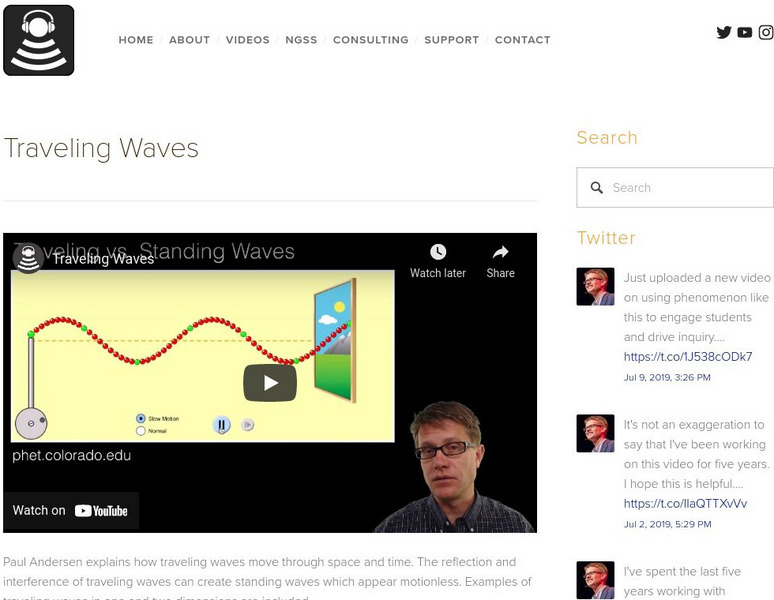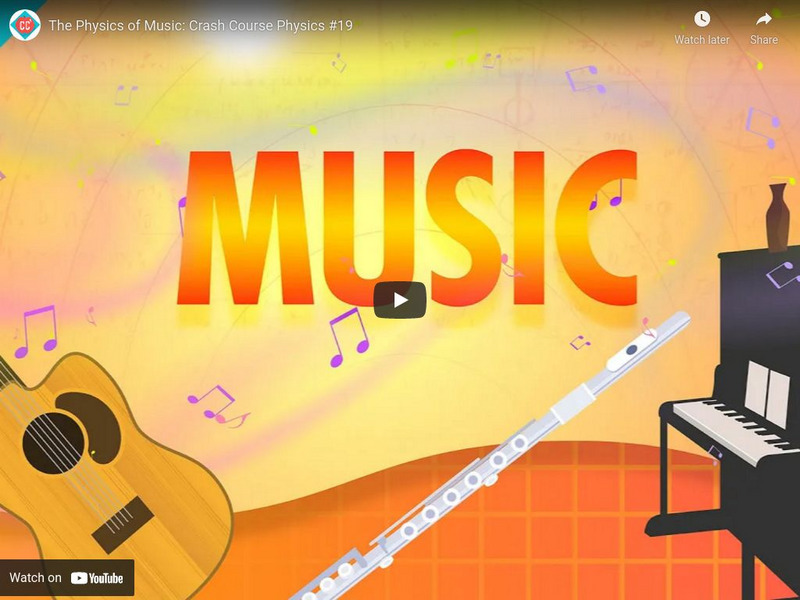Bozeman Science
Harmonics
In this video Paul Andersen explains how the wavelength of a standing wave is determined by the boundary length and frequency of the wave. The fundamental frequency has a wavelength double the boundary length. Harmonics are built on the...
Bozeman Science
Standing Waves
In this video Paul Andersen explains how standing waves are created through the reflection and interference of traveling waves. Destructive interference creates areas of no movement called nodes. Constructive interference creates areas...
Bozeman Science
Traveling Waves
In this video Paul Andersen explains how traveling waves move through space and time. The reflection and interference of traveling waves can create standing waves which appear motionless. Examples of traveling waves in one and two...
PBS
What are the Strings in String Theory?
Why strings? What are they made of? How did physicists even come up with this bizarre idea? And what's all this nonsense of extra dimensions?
Bozeman Science
Wave Interference
In this video Paul Andersen explains how waves interact with objects and with other waves. When a wave hits a fixed object it will be reflected and inverted. When a wave hits a free object it will be reflected without being inverted. ...
Curated Video
Rubens' Tube
We create a Rubens\u2019 Tube to demonstrate the movement of sound waves. A tube lined with holes is filled with propane and connected to a speaker. We light the gas coming from the holes and play different frequencies and volumes of...
Flipping Physics
2016 #5 Free Response Question - AP Physics 1 - Exam Solution
My solutions to Free Response Question #5 from the 2016 AP Physics 1 Exam. This is a standing waves question which requires you to determine the relationship between tension and wave speed. Also included are my reflections on how to get...
Flipping Physics
AP Physics 1: Review of Mechanical Waves
Review of the Mechanical Waves topics covered in the AP Physics 1 curriculum.
Physics Girl
I built an acoustic LEVITATOR! Making liquid float on air
Ultrasonic levitation, IN YOUR HOME! Learn how an acoustic levitator works and how to make one.
Professor Dave Explains
Quantum Mechanics and the Schrodinger Equation
Okay, it's time to dig into quantum mechanics! Don't worry, we won't get into the math, we just want to understand what the math represents, and come away with a new and improved view of the electron as both a circular standing wave and...
Flipping Physics
Stringed Instrument Frequencies
The equation for the harmonic frequencies of stringed instruments is derived. Harmonic numbers and fundamental frequency are defined. A guitar is used to demonstrate harmonic numbers.
Physics Girl
Singing plates - Standing Waves on Chladni plates
Use physics to create cool patterns on a vibrating plate. How is this like a guitar string or a singing wine glass?
Flipping Physics
How Is This Standing Wave Possible?
When standing waves are allowed at 15, 30, and 45 hertz on a string, then we should not see a standing wave pattern at 22 hertz. Yet, we do in this demonstration. This explains why.
Professor Dave Explains
Standing Waves and Harmonics
Not all waves travel across the ocean or across the universe. Some are stuck in a certain spot! Like the vibrations of the strings on a guitar. What's the deal with these standing waves? And what's this, quantization? Oh my! We'd better...
Physics Girl
How I broke a wine glass with my VOICE (using science!)
If you sing at a wine glass at its exact resonant frequency, you can break the glass without the help of a speaker! Learn the physics behind that.
Mazz Media
Natural Frequency and Resonance
This video engages students by asking questions and showing phenomena that relate to simple harmonic motion. The program provides examples and demonstrations using “singing” glasses, violin and piano sounding boards, oscillations in...
Flipping Physics
Resonance Introduction using 9 Demonstrations
Resonance is introduced and demonstrated using a “singing rod”, a swing, a goblet, a hollow tube in water, a hollow tube open on both ends, a seashell, a broken speaker, a human body and a key fob, and a shorter “singing rod”....
Bozeman Science
Bozeman Science: Traveling Waves
Paul Andersen explains how traveling waves move through space and time. The reflection and interference of traveling waves can create standing waves which appear motionless. Examples of traveling waves in one and two dimensions are...
Bozeman Science
Bozeman Science: Standing Waves
Paul Andersen explains how standing waves are created through the reflection and interference of traveling waves. Destructive interference creates areas of no movement called nodes. Constructive interference creates areas of maximum...
Crash Course
Crash Course Physics #19: The Physics of Music
Music plays a big part in many of our lives. Whether you just like to listen or you enjoy playing an instrument, music is powerful. So what is music? How does it work? What are the physics of music? In this video episode of Crash Course...



